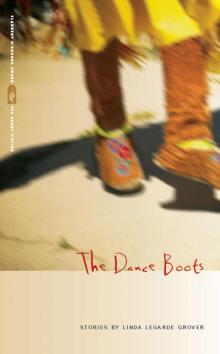Read The Dance Boots Storyline:
In this stirring collection of linked stories, Linda LeGarde Grover portrays an Ojibwe community struggling to follow traditional ways of life in the face of a relentlessly changing world.In the title story an aunt recounts the harsh legacy of Indian boarding schools that tried to break the indigenous culture. In doing so she passes on to her niece the Ojibwe tradition of honoring elders through their stories. In “Refugees Living and Dying in the West End of Duluth,” this same niece comes of age in the 1970s against the backdrop of her forcibly dispersed family. A cycle of boarding schools, alcoholism, and violence haunts these stories even as the characters find beauty and solace in their large extended families.With its attention to the Ojibwe language, customs, and history, this unique collection of riveting stories illuminates the very nature of storytelling. The Dance Boots narrates a century’s evolution of Native Americans making choices and compromises, often dictated by a white majority, as they try to balance survival, tribal traditions, and obligations to future generations.From Publishers WeeklyWinner of this year's Flannery O'Connor Award for Short Fiction, Grover's stories work back in time to retrace the rupturing experience of Western schooling on the Ojibwe tribes in Minnesota during the early 20th century. In the title story, narrator Artense's beloved Aunt Shirley is dying of lung cancer as she recounts "the breaking of a culture through the education of its young." In addition to the history, Artense, the oldest child and the first high school graduate, is given Shirley's cherished dancing boots. The intergenerational key is grandma Maggie, who, in "Maggie and Louis," is educated at a mission school and meets her future husband while working as a teacher's assistant at the forbidding Harrod boarding school, which Indian children, taken from their reservations, are forced to attend. Later, in "Three Seasons," Maggie, now a worn-out mother and wife, leaves her drunken and abusive husband and takes her children to live with her alcoholic sister. Even in escape, Maggie has a harsh road ahead, and it's her generous spirit that permeates the stories of the later generations and lends this collection a bright and determined vitality. Copyright © Reed Business Information, a division of Reed Elsevier Inc. All rights reserved. From BooklistIn linked stories, Grover portrays the inhabitants of an imaginary Ojibwe reservation north of Duluth, Minnesota. While Artense, the narrator, attends community college and goes on to graduate school, her aunt Shirley, who lives in Duluth, calls her every couple of weeks to tell her family stories, which Artense passes on to us. Shirley’s multigenerational tale involves Indian boarding schools, homesickness, and racism. Readers also meet Grandma Maggie, who hits her husband with a frying pan, then takes off with her two youngest boys because her three oldest are already at the Indian school; Louis, Maggie’s first husband, whom she meets at the Harrod Indian School; and Sonny and Mickey, who repeatedly escape from Harrod. Before Shirley dies, she gives Artense her suede beaded dancing boots, and Grover writes lyrically of the first time Artense wears them to a powwow, while watching her own daughters join the line of dancing grandmothers, aunts, and cousins. Grover’s collection, for which she won the Flannery O’Connor Award for Short Fiction, is simply mesmerizing. --Deborah DonovanPages of The Dance Boots :
